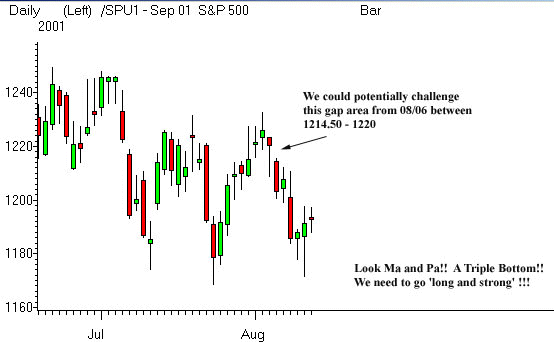Gentlemen, Start Your Engines
The market tipped its
hand yesterday. With giants like Merrill Lynch
(
MER |
Quote |
Chart |
News |
PowerRating) and Goldman
Sachs
(
GS |
Quote |
Chart |
News |
PowerRating) coming out positive on the semiconductor group (imagine that!),
the big boys knew exactly what buttons to push to get the speculative juices
flowing again. Forget about the fact that the actual companies who are in the
semiconductor business are experiencing unprecedented losses and lack of orders
in the global marketplace, these firms are once again asking us to reach for our
wallets and buy because “the market doesn’t wait for the actual recovery
to occur and it doesn’t care about what happened yesterday or today — it is only
concerned with what is going to happen six to 12 months out.”
As my dear friend Richard Russell says, that
works in a bull market environment when business conditions are exerting
positive pressures on corporate earnings and the overall economy is providing a
favorable backdrop. However, technicians and realists like myself have compiled
a lot of material over the past 15 months or so that suggest that not only are
we not in a bull market anymore, but have entered a secular bear market
(blasphemous!). Therefore, the market’s discounting of news/valuations, etc.,
that has been successfully applied to periods of weakness in the past 20 years,
should now be thrown out with yesterday’s Pokemon cards (trash).
The path of the market and the intentions of the
mightiest of market participants is quite clear here. Carolyn Lueck identified
some positive divergences occurring within the Nasdaq index last Thursday on her
post on the TMWorld message boards. Clearly, smart money knew that a mighty
market stimuli was waiting nearby in the wings. Add this to the fact that the
indexes once again bounced for the third time off areas of universally watched
support, and before you know it, you got the record number of shorts in the
market on the run.

Once again, the market has spoken (through the
Divinely Chosen lips of Goldman Sachs), and the word to remember for the next
30-45 days is: distribution. In our opinion, we will probably observe one to
one-and-a-half months of an uptrend, in which some of the Johnny-come-lately shorts will get
toasted and Wall Street will successfully suck in billions of dollars of
sideline money.
Market strategists like Don Hayes and Hochberg/Prechter
of EWI have been bullish for the past two months, looking for a move above the
May highs due to either incredibly oversold TRIN readings and/or major Elliott
Wave formations that have pointed to higher prices. Both of these guys are top-notch
technicians who have been thrown a curve ball by a treacherous July, but their
moments in the sun are probably now upon us. Certainly with the Japanese Nikkei
gaining over 4% last night, the speculative high octane is just waiting to come
out and fuel the technology pace car.Â
We will now favor trades from the long side until
further notice with the assumption that a 30-45 calendar day period of strength
will be upon us. However, we are watching the plight of the US dollar very
carefully, as any measurable weakness in the USD will change us back to a
bearish stance very quickly.
Ned Riley of State Street Investments was on CNBC
yesterday and actually stated: “The secular period of strong earnings
growth in the tech sector is still here,” insisting that investors not be
afraid of tech stocks, citing extreme investor negativity towards the technology
sector. First of all, I want to go on record by saying that I strongly recommend
mandatory drug testing of television financial commentators prior their
getting air time. Heck, the Bulgarian weightlifter who is getting all juiced up
so he can lift the equivalent of a Ford Taurus is not going to cost us money if
he fails, but he is watched closer than an American tourist on a beach in the
South of France (sorry about going off on this tangent, the market is opening in
20 minutes).Â
Second, I agree that perhaps some of the short-term
sentiment is negative surrounding the sector, but bear markets of the past
century have clearly revealed that a phase of absolute disdain for stocks and
the stock market in general is absolutely essential in creating the proper low
valuations necessary for a bottom to be in place. At present, we continue
to observe record high levels of equity allocation recommendations as well as
multitudes of analysts claiming that the elusive and much-publicized bottom is
already in place, and that investors should load up or miss the next period of
record-breaking appreciation.
We don’t agree with these statements and feel as
though those who are patient and astute will be well positioned in the next
12-18 months to take advantage of stock prices at true discounted valuations.
Patience rules at this game.Â
Goran
Â
